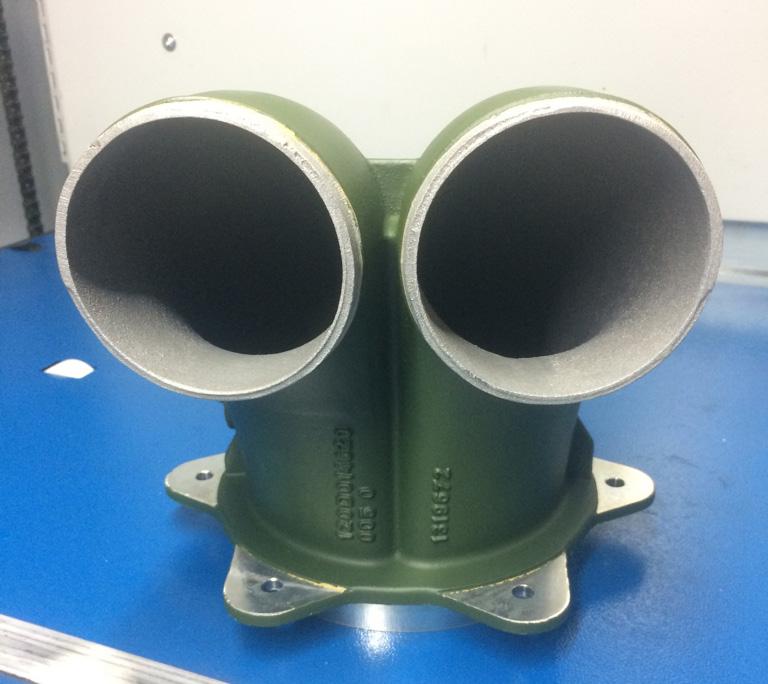
4 minute read
Printing Spare Pars at Remote
A reduction of 72% on inventory levels, average cost savings of 47%, and higher availability of equipment. Based on recent research, these could be the benefits of using a 3D printer for spare part inventories at remote locations. Rob Basten, professor at Eindhoven University of Technology (TU/e) and Jelmar den Boer, Commander of 11 Supplycompany Air Assault of the Royal Netherlands Army (RNLA), talk about their research and findings.
TEKST & DESIGN Stefano Dimastrapasqua
Advertisement
Printing Spare Parts at Remote Locations
Many organizations have sophisticated supply chains, certainly also organizations that operate at remote geographic locations: oceangoing transport, offshore, mining companies, or the military. Due to the absence of supporting infrastructure, transportation is expensive and lead times are high. Therefore, spare part deliveries are generally part of larger, consolidated shipments that occur periodically. Additionally, the often difficult conditions of the remote locations create high uncertainty on, firstly, the demand for spare parts and, secondly, the required spare parts inventories. Consequently, stock-outs of spare parts occur. In most cases, this results in additional shipments before the planned periodical shipment: expediting. Jelmar: “For us, the RNLA, our deployment is our primary focus. If we need a spare part to operate successfully, and we do not have it in inventory, we expedite. This sometimes results in a single flight for just one spare part.” To minimize expediting, the RNLA takes many spare parts on a mission. However, not all spare parts are necessary during the period of the mission. Rob: ‘You do not know beforehand which and how many spare parts will be needed. Therefore, a lot of spare parts are transported to the remote location and a lot are returning unused after the mission. Obviously, this results in a lot of unnecessary transportation and holding costs. It isn’t very sustainable either.’ A potential solution to decrease the total costs of inventories in remote locations is threedimensional (3D) printing. This rapidly developing technology makes it possible to print spare parts locally. Therefore, expediting and unnecessary holding of inventory could be replaced with raw materials and a 3D printer. To see what the potential benefits of a 3D printer located at remote locations could be, Bram Westerweel, Rob Basten, Jelmar den Boer, and Geert-Jan van Houtum started research. Within their research they focused on two aspects: When should an organization print or expedite, and what are the potential benefits of a general-purpose 3D printer in terms of operating costs, on-

One of the three vehicles (Sourse: Ministry of Defense)

Two suitable parts for printing

site spare parts inventories, and system availability? A generalpurpose 3D printer can print many different types of parts of reasonable quality, but not top quality. However, the printer is not expensive and is relatively easy to manage, which makes it suitable for almost any organization.
The model
To come up with results, the researchers proposed a model with three supply options: expedite, print, and wait for regular parts via the next replenishment. An important assumption within the model is the use of a 3D printed spare part as a temporary replacement. Rob: ‘We knew the reliability of a spare part printed from a general-purpose 3D printer was sufficient for one or two weeks. Therefore, we assumed that the printed parts constitute temporary solutions and are removed as soon as regular spare parts become available.’
The model was applied to a case study of the RNLA for her United Nations peacekeeping mission in Mali. Data were available of 3,000 parts of three types of vehicles. From these parts, a random sample was taken of 100 parts. Each of these parts was checked by experts to determine whether the part was suitable for printing. Rob explains why: “The RNLA already had a general-purpose 3D printer in Mali and could therefore only print composite parts.’’ Jelmar elaborates: “With the printer, we can print small plastic components, such as ammunition clips.’”
More information?
It turned out that 14 parts were suitable for printing. In a case study with these 14 parts, Bram, Rob, Jelmar, and Geert-Jan concluded that, compared to only having regular shipments, the usage of the 3D printer could reduce the costs by 47% on average, and the inventory levels by 72%.
The future of 3D printing
The results are promising for all organizations that operate at remote locations: With 3D printing, money can be saved, inventory levels can be reduced, and still equipment availability can go up. Nevertheless, before 3D printing really could be used at remote locations, further research should be conducted. According to Rob and Jelmar, there are three categories for future research: the exact location where to print (at the remote location or some safer location near the remote location), the consequences of IP rights on 3D printing, and the potential of predictive maintenance for parts when printing higher quality parts takes multiple days.
Although more research should be conducted, 3D printing is already part of the agenda of the Ministry of Defence. Jelmar: “Since the paper, we are looking at what 3D printing could do for us. We now have a project where we cluster all the information and knowledge we have about 3D printing and use it to improve the operational side of the military. Therefore, it could only be a manner of time 3D printers will be used in our operations.”
You can find the complete journal paper at https://doi.org/10.1111/poms.13298 . If you are interested in this research or future research on this topic, feel free to contact Rob Basten (r.j.i.basten@tue.nl). If you are interested in research for the RNLA, feel free to contact Jelmar den Boer (J.d.Boer.02@mindef.nl).










